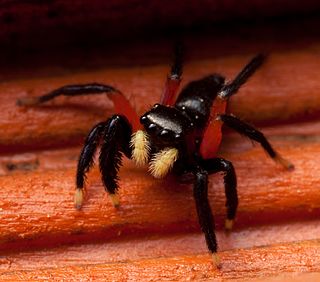Euophrys omnisuperstes, the Himalayan jumping spider, is a small jumping spider that lives at elevations of up to 6,700 m (22,000 ft) in the Himalayas, including Mount Everest, making it a candidate for the highest known permanent resident on Earth. They are found among rocky debris, feeding on tiny, stray springtails and flies.

Euophrys monadnock is a species of jumping spider which occurs in the United States and Canada. It was first described by James Henry Emerton in 1891.
Plexippus clemens is a species of jumping spiders that lives in Egypt, India, Iran, Israel, Libya, Turkey and Yemen. Originally placed in the genus Salticus by Octavius Pickard-Cambridge in 1872, the species was transferred into the genus Euophrys by Eugène Simon in 1876, into Menemerus by Jerzy Prószyński in 1984 and eventually into Plexippus by Prószyński in 2003.
Phintella pygmaea is a jumping spider species that lives in China. The species was originally placed in the genus Euophrys by Wanda Wesołowska in 1981, but was transferred to the genus Phintella in 2000. Only the female has been described.
Euophrys bifida is a jumping spider species in the genus Euophrys that lives in South Africa. It was first described in 2014.
Euophrys cochlea is a jumping spider species in the genus Euophrys that lives in South Africa. It was first described in 2014.
Euophrys elizabethae is a jumping spider species in the genus Euophrys that lives in South Africa. It was first described in 2014.
Euophrys falciger is a jumping spider species in the genus Euophrys that lives in South Africa. It was first described in 2014.
Euophrys gracilis is a jumping spider species in the genus Euophrys that lives in Lesotho and South Africa. It was first described in 2014.
Euophrys griswoldi is a jumping spider species in the genus Euophrys that lives in Namibia. The male was first described in 2014.
Euophrys limpopo is a jumping spider species in the genus Euophrys that lives in South Africa. The male was first described in 2014.
Euophrys maseruensis is a jumping spider species in the genus Euophrys that lives in Lesotho. It was first described in 2014.
Euophrys meridionalis is a jumping spider species in the genus Euophrys that lives in South Africa. The species was first described in 2014.
Euophrys subtilis is a jumping spider species in the genus Euophrys that lives in South Africa. It was first described in 2014.
Euophrys recta is a jumping spider species in the genus Euophrys that lives in South Africa. The male was first described in 2014.
Euophrys nana is a jumping spider species in the genus Euophrys that lives in South Africa. The male was first described in 2014.
Euophrys miranda is a jumping spider species in the genus Euophrys that lives in South Africa. The female was first described in 2014.

Heliophanillus fulgens is a jumping spider species in the genus Heliophanillus that can be found in a large distribution that extends from Greece to Central Asia.
Sittisax is a genus of spiders in the family Salticidae.
Saphrys tehuelche is a species of jumping spider. The species was classified in the genus Euophrys from its first description by María Elena Galiano in 1968 until 2015. It can be found in Chile.

